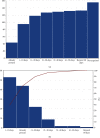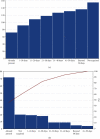Milestones and Timescale of Poststroke Recovery: A Cohort Study
- PMID: 33282006
- PMCID: PMC7688349
- DOI: 10.1155/2020/8216758
Milestones and Timescale of Poststroke Recovery: A Cohort Study
Abstract
Background: Progressive increase of an aging population in Western countries will result in a growth of stroke prevalence. As many stroke survivors chronically show severe disability, increase in economic, social, and medical burden could be expected in the future. Objective and subjective measures of poststroke recovery are necessary to obtain predictive information, to improve the treatments, and to better allocate resources.
Aim: To explore a measure of the temporal dimension of poststroke recovery, to search for predictive association with multiple clinical variables, and to improve tailoring of poststroke treatments.
Method: In this observational monocentric cohort study, 176 poststroke inpatients at their first cerebrovascular event were consecutively enrolled. A novel measure based on the time needed to reach the main milestones of motor recovery was proposed. Moreover, two commonly used outcome measures, a measure of global functioning (Functional Independence Measure (FIM™)) and a measure of neurological poststroke deficit (Fugl-Meyer scale), were collected for the investigations of possible predictors.
Results: The patients showed a substantial increase in Fugl-Meyer and FIM scores during the rehabilitative treatment. The acquisition of three milestones was significantly associated with female sex (autonomous standing), length of stay and Fugl-Meyer initial score (autonomous walking), and Fugl-Meyer initial score (functional arm). These findings provided quantitative data on motor milestone reacquisition in a sample of poststroke patients. It also demonstrated the value of the Fugl-Meyer score in predicting the acquisition of two motor milestones, relevant for daily life activities.
Conclusion: Systematic recording of the timescale of poststroke recovery showed that motor milestone reacquisition happens, on average and when attainable, in less than 30 days in our sample of patients. The present study underscores the importance of the Fugl-Meyer score as a possible predictor for better improvement in reacquisition times of milestone functional recovery.
Copyright © 2020 Marianna Loi et al.
Conflict of interest statement
The authors declare that the research was conducted in the absence of any financial or nonfinancial relationships that could be construed as a potential conflict of interest. The present research was performed as part of the activities of the authors as employees of “Istituti Clinici Scientifici Maugeri IRCCS”.
Figures




Similar articles
-
Revisiting the Proportional Recovery Model in View of the Ceiling Effect of Fugl-Meyer Assessment.Stroke. 2021 Oct;52(10):3167-3175. doi: 10.1161/STROKEAHA.120.032409. Epub 2021 Jun 17. Stroke. 2021. PMID: 34134508
-
Lifetime and Acute Stress Predict Functional Outcomes Following Stroke: Findings From the Longitudinal STRONG Study.Stroke. 2023 Nov;54(11):2794-2803. doi: 10.1161/STROKEAHA.123.043356. Epub 2023 Sep 28. Stroke. 2023. PMID: 37767737 Free PMC article.
-
Understanding of the Lower Extremity Motor Recovery After First-Ever Ischemic Stroke.Stroke. 2022 Oct;53(10):3164-3172. doi: 10.1161/STROKEAHA.121.038196. Epub 2022 Jun 17. Stroke. 2022. PMID: 35713003
-
The fugl-meyer assessment of motor recovery after stroke: a critical review of its measurement properties.Neurorehabil Neural Repair. 2002 Sep;16(3):232-40. doi: 10.1177/154596802401105171. Neurorehabil Neural Repair. 2002. PMID: 12234086 Review.
-
Effectiveness of Virtual Reality- and Gaming-Based Interventions for Upper Extremity Rehabilitation Poststroke: A Meta-analysis.Arch Phys Med Rehabil. 2020 May;101(5):885-896. doi: 10.1016/j.apmr.2019.10.195. Epub 2019 Dec 7. Arch Phys Med Rehabil. 2020. PMID: 31821799
References
-
- Graham L. A. Organization of rehabilitation services. In: Barnes M. P., Good D. C., editors. Handbook of Clinical Neurology, Neurologic Rehabilitation. Vol. 110. Amsterdam: Elsevier; 2013. pp. 113–120. - PubMed
-
- Musicco M., Emberti L., Nappi G., Caltagirone C., for the Italian Multicenter Study on Outcomes of Rehabilitation of Neurological Patients Early and long-term outcome of rehabilitation in stroke patients: the role of patient characteristics, time of initiation, and duration of interventions. Archives of Physical Medicine and Rehabilitation. 2003;84(4):551–558. doi: 10.1053/apmr.2003.50084. - DOI - PubMed
Publication types
MeSH terms
LinkOut - more resources
Full Text Sources
Medical
Research Materials

